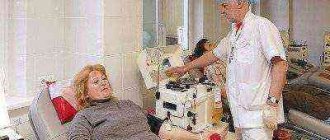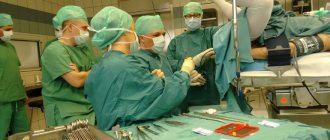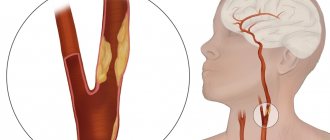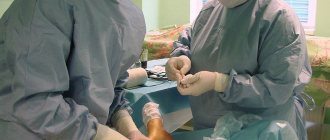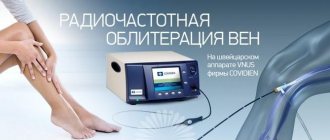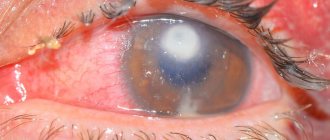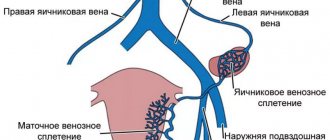Endovasal laser coagulation (EVLC) of veins in Moscow
Endovasal laser coagulation (EVLC) of veins is a modern method of getting rid of truncal enlargement of veins using the thermal effect of laser energy. In this case, the vein is preserved, just as in a standard, usual operation; it is burned out from the inside. This contributes to thrombotic occlusion of the vein, its compression and gradual resorption. The technique is carried out under the control of a special scanning - color duplex, which allows you not to cut the skin, but to carry out the procedure through tiny punctures.
EVLT - endovasal laser coagulation in our center
Preparation for EVLT
1
Vascular ultrasound. As a rule, an ultrasound examination is performed by a phlebologist in order to assess the length, bend and other characteristics of the affected vessels. Along with this, duplex scanning of the veins and arteries of the lower extremities is performed to detect blood clots, atherosclerotic plaques, vascular spasms and other pathologies.
2
Standard preoperative preparation. As before any other surgical intervention, the patient will have to undergo an ECG, undergo fluorography and laboratory tests of blood and urine, and also receive consultation with a therapist. You can undergo all the necessary examinations before treatment for varicose veins at the Miracle Doctor clinic.
3
Consultation with a phlebologist. If the patient is taking medications that affect the blood coagulation system (hormonal contraceptives, aspirin, etc.), the doctor must be told about this. The specialist will adjust the schedule for taking them taking into account the upcoming operation.
4
Preparation on the day of the procedure. The patient is advised to refrain from eating and drinking 4 hours before surgery. You should also wear loose clothing as you will need to wear compression stockings immediately after the procedure. If necessary, the doctor will provide the patient with individual advice on preparation.
History of the method “Endovasal laser coagulation EVLT” (Wikipedia)
The first exciting reports about the possibility of using lasers in the treatment of phlebology patients appeared in 1981. Dr. Anderson RR and colleagues used a dye laser with a wavelength of about 577 nm, the principle was to damage the microvessels of the skin. The development of the foundations of the technology was based on the process of tissue absorption of laser energy having a certain wavelength, which resulted in their selective destruction.
Only in the 90s of the last century, when new semiconductor structures were released, did it become possible to produce compact lasers. These devices had a long service life at a fairly low cost. In 1998-1999, the first information began to appear about the beginning of clinical manipulations based on the intravascular use of a diode laser for endovasal laser coagulation. As a result, only in 2002 this method was patented by V. Meloni and his colleagues.
Since the advent of the method - endovasal laser coagulation of varicose veins, a video of which was filmed for a more in-depth study of the process, there has been a tendency to increase the energy power supplied to the vessel. The earliest work was carried out at a power of no more than 15 W, and after research work carried out by a number of scientists, reports of high power levels not exceeding 40 W appeared.
The endovasal laser procedure is performed by surgeons and phlebologists Semenov A.Yu. and Kalachev I.I.
Endovasal laser coagulation EVLT in Moscow is of great interest to both surgeons and their patients. The number of publications and studies on this topic increases every year. Endovasal laser coagulation of varicose veins, the price of which may vary depending on the equipment, is becoming more popular every year, thanks to patient education, and is in increasing demand.
Despite all the existing experience, the technology of endovasal laser coagulation is currently still very far from perfect. Therefore, research continues in two directions: standardization of technology and clarification of indications, determining the optimal wavelength of the laser beam.
How is the EVLT procedure performed?
In the classic version, EVLT eliminates any incisions.
Under ultrasound control, the vein to be laser obliterated is marked in a vertical position: the projection of the vein is simply drawn with a marker on the skin. Its tributaries are also distinguished.- Through a small puncture (after preliminary local anesthesia), a vein is punctured with a special venous catheter. Actually, the injection of anesthetic before the puncture is the only painful sensation during this operation.
- A laser light guide is inserted through the catheter. Under ultrasound control, the light guide is passed to the site of the vein anastomosis.
- Tumescent anesthesia is performed - infiltration around the altered vein with a combined solution containing the anesthetic lidocaine, adrenaline and saline. solution. This infiltration not only provides anesthesia, but also protects surrounding tissues from burns.
- Then the EVLO itself is carried out - laser radiation is turned on and reverse traction of the light guide is performed at a certain speed (the speed of the light guide is usually standard, developed on the basis of clinical trials, but can vary depending on the diameter of the vein and the wavelength of laser radiation).
- Varicose tributaries are sclerosed or removed through micropunctures.
- After the procedure, a compression bandage is applied (special latex rollers on the vein, attached to the skin with a plaster) and compression stockings of the second degree of compression.
Compression stockings must be purchased in advance; the doctor will advise which ones at a preliminary consultation.
Endovasal laser coagulation (EVLC) on the veins of the lower extremities - what is it?
The principle of performing the endovasal laser coagulation procedure is based on the thermal effect of laser radiation on the inner part of the surface of the vein. But, as we found out through a huge number of different types of research, the laser does not fully affect the surface of the vessel walls. Most of the energy is absorbed by the blood contained in the vessel. In the blood, already under the influence of a light pulse, steam bubbles are formed, which come into contact with the wall of the vein, resulting in a thermal effect. Next, coagulation of proteins occurs in deeper layers due to damage to the endothelium.
It is the destruction of the endothelium that is of primary importance as a result of treatment. Some viable endothelial cells are preserved, which in the future will be an important source of wall regeneration. The destruction process must be complete, and this is only possible as a result of creating an optimal laser radiation energy density in the lumen of the vessel, which results in its “charring.” However, you should carefully select the laser power, otherwise, with a stronger impact of the device, the vessel wall may be perforated.
What happens to the vein during laser radiation during EVLT
The latest models of lasers for endovasal laser coagulation have a wavelength of 1940 nm, at which the laser radiation is absorbed to a greater extent by the water of the venous wall and the blood itself. Direct exposure to the vein wall reduces the radiation strength, the appearance of charring and heating of the working surface. This contributes to a lower likelihood of perforation of the vessel wall and the appearance of pain in the postoperative period. This wavelength is ideal for larger venous trunks that have a diameter of more than 10 mm.
How is laser vein treatment (EVLT) performed?
First of all, I perform a duplex study of the veins of the leg that we are going to treat. This is necessary in order to:
- once again clarify which veins need to be treated with the laser;
- mark the location of the veins;
- determine the level of introduction of the light guide and the path of its advancement;
- find out the required diameter and type of fiber.
At the very beginning of the EVLT procedure, I numb the site where the catheter is inserted into the vein by injecting Lidocaine solution through a thin needle.
Next, under ultrasound control, a catheter is installed into the vein, through which a laser light guide is inserted. The end of the light guide is located at the level that was determined during preoperative marking.
Before the laser begins “sealing” the vein, so-called tumescent anesthesia is performed. Under ultrasound control, a local anesthetic solution is injected along the vein. In this case, injections and a moderate feeling of fullness are felt inside the leg, along the vein. This unpleasant sensation passes relatively quickly.
Once everything is ready, the laser turns on. A special device, at a given speed, pulls the light guide, removing it from the vein. Traction with the help of the device allows for uniform exposure of the laser radiation to the vein wall along its entire length.
After removing the light guide from the vein, bandages are applied to the leg and compression stockings are put on.
This procedure lasts on average about 25 minutes.
Next, you get up and go home, following the recommendations that I will give you.
Indications for the EVLT procedure:
- The estuarine expansion of the vein can be of absolutely any diameter. Since modern laser generators and radial light guides are capable of closing veins regardless of their diameter. All methods for carrying out such manipulations are standardized and have excellent results.
- A fairly straight main vein. If there are bends, it can be difficult to pass through the endovasal guide; in such cases, several light guides are placed.
A complex case - EVLT after thrombophlebitis: several light guides were installed
Laser treatment for varicose veins on the legs
The essence of the laser vein removal procedure (laser coagulation) lies in the principle of sealing. The laser “glues” or “seals” the diseased venous or capillary vessel, thus destroying its structure and removing it from the general blood flow system. The method involves almost no trauma to the skin and muscle tissue (incisions) and takes only 30-40 minutes on an outpatient basis.
Conventionally, laser coagulation can be divided into 2 stages:
- The effect of the laser on the subcutaneous venous vessel, with disturbances in the functioning of the valves.
- Impact on the tributaries of the main venous vessels, which are the cause of “disfigured” legs.
At the end of the coagulation procedure, blood circulation passes only through healthy veins, and the patient feels significant relief within 24 hours.
In most cases, women over 40 years old suffer from varicose veins. Along with the consequences, they are concerned about the unaesthetic appearance of their own legs, which they are forced to hide under trousers and long clothes. The ability to quickly solve the problem and restore the appearance with minimal risks is one of the main advantages of the method.
Contraindications to the EVLT procedure:
- Established thrombophilia, since the method of endovasal laser coagulation implies the formation of a blood clot near the lumen of the femoral or popliteal vein and further blood clotting, which is a threat to the thrombotic process in the veins and thromboembolism of the arteries of the lungs.
- Chronic ischemia of the lower extremities, since an important stage of laser coagulation is the mandatory use of compression bandages for some time after surgery, which can aggravate ischemia.
- Inability to activate the patient after surgery. It is known that the best way to prevent postoperative complications is to mobilize the patient. The endovasal laser coagulation method requires the patient to get up from the operating table independently and move for a certain time.
- The presence of inflammation in the intervention area, which can serve as a source of infection.
Contraindications to laser treatment of veins
The main contraindications are:
- Inflammatory changes in the skin and subcutaneous tissue at the site of the planned procedure.
- The diameter of the vein is more than 1 cm.
- Impaired walking function due to other diseases (arthrosis, consequences of stroke, other diseases of the lower extremities).
- Acute infectious diseases or decompensation of chronic somatic diseases.
- Stenosing diseases of the arteries of the lower extremities. With these diseases, the blood supply to the legs is impaired, and EVLT can aggravate this situation.
- Increased number of platelets in the blood (increases the risk of blood clots).
- Repeated history of thrombosis.
- Pregnancy and breastfeeding.
- High obesity, as it makes necessary postoperative compression difficult.
Endovasal laser coagulation of varicose veins - procedure technique
The operation - endovasal laser coagulation (EVLC), the video of which you can watch on this page of our website, occurs as follows: markings are carried out on the patient’s skin using ultrasound control.
Kalachev I.I. carries out markings before EVLT surgery
Then the lower limit of reflux is determined directly, which is located at the junction of a large inflow. The second mark is placed 3-4 cm distal from the first, where the puncture will be performed. Next, the points of confluence of the tributaries are marked and varicose dilated tributaries are marked, regardless of the method of removal.
Venous puncture is performed only under ultrasound guidance
The technique of endovasal laser coagulation includes five steps:
- Puncture of the saphenous vein and direct insertion of the light guide.
- Determination of the working section of the light guide.
- Beginning of anesthesia.
- Application of laser.
- Application of a bandage.
Efficiency
- The laser coagulation procedure is highly effective and has many important advantages.
- Since there is no need for large incisions, the risk of injury is extremely low.
- The procedure is carried out under local anesthesia, making it absolutely painless and almost imperceptible.
- The recovery period after surgery, on average, lasts up to seven days and does not require bed rest.
- In 98% of cases, patients experience complete recovery with no recurrence of varicose veins.
- The operation is absolutely safe, since each stage is strictly controlled.
- Proper implementation of the procedure does not imply side effects.
- Veins and blood vessels return to normal quickly, and not the slightest spots or scars remain on the skin.
Further in the article: how laser surgery for varicose veins is performed and its price.
Endovasal laser coagulation (EVLC) - postoperative period
After the compression stocking is put on, the patient should walk for at least 40 minutes.
After EVLT surgery, compression stockings are worn.
24-hour compression lasts 2 days. Then only during the daytime for about a month. The first scheduled examination with ultrasound angioscanning occurs the next day.
Quite rarely, more often in patients with a low pain threshold, complications are rare in the first 24 hours after the procedure - endovasal laser coagulation (EVLC). There may be slight pain in the limb. Discomfort is more often associated with an incorrectly worn compression stocking, which puts pressure on the limb, rather than with postoperative trauma.
Endovasal laser coagulation (EVLC), photos of the postoperative period of which demonstrate that there may also be bruising along the length of the coagulated vein, is the safest procedure for varicose veins. The cause of bruising may be penetration into small capillaries during tumescent anesthesia. Sometimes there is a feeling of tension in the thigh, a feeling of tension in the vein. This all usually goes away within 1.5 months. A short-term increase in body temperature to subfebrile levels is possible.
In about a fifth of patients, 4-6 days after endovasal laser coagulation, a pulling sensation may appear along the vein - this is normal!
Over the past 3 years, endovasal laser coagulation (EVLC), the cost of which is still quite high, has undergone a number of changes. For example, the most modern laser devices have appeared, such as water lasers.
Modern laser technologies in
Another important change is the formation of deep understanding among phlebologists about the presence of important indications for this technique. Endovasal laser coagulation of varicose veins, the reviews speak for themselves, has recently become widely known and has earned trust among doctors and patients. Over the course of several years, vast experience has been accumulated in the use of endovasal laser coagulation to eliminate venous pathology, and relevant new findings have been published in all world medical publications on phlebology.
Postoperative period
Immediately after EVLT, the patient should walk for 40 minutes. This is required in order to reduce the risk of thrombolytic complications. Maintaining physical activity is essential for the patient's successful recovery.
Subsequently, it is also recommended to walk at a calm pace for at least 1 hour daily. However, you must refrain from intense physical activity for at least 1 month. You should also not take a hot bath or go to a sauna.
Compression stockings should be worn around the clock for 5 days, then during the day for another 2 months. If the patient’s work activity is associated with sedentary work, then this period should be even longer. This requirement must be met in order for the vein to be completely “brewed”.
You should return to the doctor for examination within 2-3 days. To assess the condition of the veins and exclude the transition of a blood clot, an ultrasound examination may be required.
On the first day after surgery, the patient may have a fever and a nagging pain along the vein. This condition can be treated with NSAIDs.
In the postoperative period, the doctor may also recommend physical therapy - 3 procedures per week for 20 minutes. All exercises are performed without removing compression garments.
Endovasal laser coagulation of veins - price for the laser procedure
The price for the endovasal laser coagulation of veins procedure in our clinic is strictly fixed, and therefore, when contacting us, patients can count on high-quality service, treatment and an affordable cost. And remember that timely consultation with a doctor will completely cure the disease and avoid its recurrence.
| Service | Treatment category | Price |
| Endovasal laser obliteration (coagulation) of veins on one lower limb (Biolitec, Germany) | Category I Initial varicose veins | 39600₽ 44000₽ |
| II category Pronounced varicose veins | 48600₽ 54000₽ | |
| III category Complicated varicose veins (for thrombosis or trophic ulcer, etc.) | 57600₽ 64000₽ | |
| Disposable radial light guide Biolitec (Germany) | One venous pool | 10000₽ |
| Total endovasal laser obliteration (coagulation) of veins on one lower limb (Biolitec, Germany) (without miniphlebectomy according to Varadi) | At any stage of varicose veins | 62100₽ 69000₽ |
| Additional laser obliteration (coagulation) of the perforating vein (Biolitec, Germany) | At any stage of varicose veins | 13500₽ 15000₽ |
| Isolated laser obliteration (coagulation) of the perforating vein (Biolitec, Germany) | At any stage of varicose veins | 35100₽ 39000₽ |
| Additional Biolitec radial light guide | When treating several venous pools on one lower limb | 10000₽ |
| Appointment with an expert phlebologist with ultrasound examination based on the results of treatment for one year | for free |
Prices for innovative procedures at the phlebology center have remained stable for many years. The cost of the endovasal laser coagulation procedure on one venous pool at the Moscow Phlebology Center is 44,000 rubles. The price of the service includes:
- Local anesthetic care.
- Cost of a disposable laser light guide.
- Cost of consumables.
- Endovenous laser coagulation procedure.
- Dressings and annual follow-up after the procedure with duplex ultrasound guidance.
For the convenience of our patients, we work with banks that offer credit lines. Also in our center there is a flexible system of discounts and installments. Payment by Visa and Mastercard is possible. At the end of the course of treatment, the patient is given a package of documents to submit to the tax office for tax deduction.
EVLT at the IMMA clinic
The specialists of our clinic are fluent in the technique of performing EVLT and have extensive experience in the treatment of varicose veins using laser coagulation. They treat patients carefully, first of all prescribing a comprehensive examination, which can be completely completed in our clinic. After receiving the final results, doctors carefully evaluate the need for the procedure, identifying all indications and contraindications. And only after this the day of the operation is set.
Advantages of classical endovasal laser coagulation:
- no skin incisions - good cosmetic effect (no stitches, scars)
- minimum rehabilitation period. After the procedure, the patient can immediately begin work.
- rare bruises and hematomas after surgery (minimal tissue trauma).
- complete absence of pain. Carrying out local tumescent anesthesia in any case guarantees the presence of motor processes immediately after the operation, so much so that the patient can leave the clinic completely calmly 60 minutes after the operation.
- minimal wearing of compression stockings after the intervention.
Well-coordinated team work
Today, endovenous laser coagulation, the cost of which can be found by calling the medical center, is the safest type of surgical intervention for varicose veins in our country.
Indications and contraindications
The decision to perform a laser coagulation procedure is made by a phlebologist. If the veins are slightly dilated and do not cause unpleasant symptoms, the doctor prescribes conservative treatment and gives recommendations for preventing further development of the disease.
Endovasal laser coagulation of varicose veins is prescribed if varicose veins become not only aesthetically unattractive, but also dangerous to health. Indications for the procedure:
- disruption of vascular valves;
- formation of spider veins;
- expansion of venous tributaries;
- violation of the trophism of the lower leg;
- varicose changes in the saphenous vein (no more than 10 mm).
There are contraindications in which the doctor will not consent to laser therapy.
Inflammation of the skin and subcutaneous layer at the site of the proposed procedure.
Patients with limited mobility. After surgery, active movement is necessary to achieve the greatest effect and prevent complications.
Obesity. Laser treatment involves wearing compression garments. If you are obese, it is impossible to provide compression.
Chronic diseases. If varicose veins develop as a result of ischemic disease, endovasal coagulation is not performed to avoid worsening the disease. With thrombophilia due to the possibility of blood clots, hemophilia - the development of extensive bleeding. Surgery is not indicated for severe forms of allergies or liver dysfunction.
Pregnancy and breastfeeding. Painkillers may harm your baby.
Endovasal laser coagulation of varicose veins - complications
Today, Russia has accumulated vast experience in the use of endovascular laser operations on the veins of the lower extremities. Therefore, the risk of complications is minimized. They are so rare that isolated cases are discussed separately at conferences.
Endovenous laser coagulation, photos of which can be viewed online, is a fairly painless, safe and simple procedure. Therefore, the demand for it is constantly growing. Every day, more and more patients prefer it to classical, outdated techniques.
FAQ
How will blood circulation change in the leg without this vein? Since the removed vein is diseased and no longer fulfills its function, but ONLY causes harm, then with its removal blood circulation improves.
Will blood flow through other veins after surgery? No, the blood flowed and will continue to flow through other veins, only with less load on them, since we got rid of the “pest”.
If this vein was needed, what would it be like now without it? Yes, this vein was needed because it fulfilled its function. But that was already in the past. Now, when the vein has “broken,” it does nothing but harm the blood flow in the leg. Therefore, the leg will feel better without it.
Will other veins take over the function of this vein? No, this vein no longer performs any function, so there is nothing to take from it. The remaining normal veins will only say: “Thank you! Now it has become much easier for us to perform our function without this pest vein.”
Endovasal laser coagulation (EVLC) reviews
Patient's review of treatment with endovasal laser coagulation in our center
Smutnaya Tatyana Nikolaevna, Obninsk. 10/04/2019
My grateful review about doctor phlebologist Dmitry Anatolyevich Fedorov.
I first met him in June 2010. At that time I was 57 years old. I developed varicose veins in my legs from the age of 30, and by this age I was already actively seeking the help of a phlebologist. A friend helped me and advised me to go to a Moscow clinic for phlebology problems, on Vasilisa Kozhina Street. The first examination was carried out by Dmitry Anatolyevich, who said that he could offer outpatient surgery and soon performed complex surgical actions requiring precision.
This was followed by attentive support and correction for 6 months, with strict implementation of the recommendations. The treatment was not difficult to tolerate. The difficulties were different: the summer of 2010 was very hot, there was smoke from forest fires in the cities, interruptions in the movement of electric trains, but all this was offset by gratitude to the doctor for my “light” legs.
My disease is chronic. Time passed, I felt the need to see the doctor again and was about to call the Moscow clinic when I found out that on Kolomenskaya, at the MIFC clinic, a phlebologist works and this is Dmitry Anatolyevich Fedorov. What a joy! THIS IS MY DOCTOR!
So in April 2020, I met with Dmitry Anatolyevich for the second time, with his big, skillful hands. This time he performed surgery on both legs using a laser. The operation was very easy. After leaving the operating room, you can continue to go about your normal life. And these are not words of advertising. This is the doctor's knowledge of modern, high-tech treatment methods. I would especially like to note that Dmitry Anatolyevich generously shares his professional knowledge; doctors were present at both of my operations, to whom he passed on his experience.
Dear Dmitry Anatolyevich, I sincerely thank you for the health of my legs and for your high professionalism. Smutnaya Tatyana Nikolaevna, Obninsk. 10/04/2019
Patient's review of the EVLT procedure performed in our
Maria, 41 years old, Moscow region, Krasnogorsk.
Endovenous laser coagulation, reviews of which I had previously studied on the Internet, turned out to be absolutely painless. I spent 3 hours in the hospital, which included the preoperative period, surgery and 30 minutes after. I was satisfied with everything. True, I had to wear special tights for a month, but it’s good that by summer I took them off. There were only 20 small punctures in the lower part of the leg, now they are no longer visible. My leg doesn’t hurt at all, but before the surgery my bad leg was constantly aching. Thanks to the phlebologist, the wonderful doctor Vladimir Vyacheslavovich Raskin for his good attitude and professional work. Maria, 41 years old.
Patient's review of endovenous laser coagulation surgery in our center
Stanislav, 47 years old, Moscow.
My leg constantly hurt, there was a buzzing sensation in it at the end of the day. I didn’t dare to have surgery using the classical method, because it was scary after reading reviews online and possible complications. Before the operation, I was offered endovenous laser coagulation, in Moscow, at the phlebology medical center MIFC, where I decided to have it done, they did an ultrasound, donated blood and that’s it. After the operation, I was forced to get up from the table and walk for about an hour. The next day I saw the doctor, I was warned that compression stockings must be worn for up to 3 weeks. I didn’t worry about the scars, although I’m glad that they are no longer visible. Six months have passed since the endovasal laser coagulation procedure. Everything is great. Thanks to all the staff from doctors to nurses and especially administrator Tatyana for your attention. Stanislav, 47 years old.
Treatment of varicose veins with laser
Before laser treatment of varicose veins, the patient will have to undergo a comprehensive examination. It is necessary in order to exclude the presence of hidden contraindications to the procedure. Since contraindications to laser surgery for varicose veins include diabetes mellitus, a tendency to thrombosis or insufficient blood clotting , the patient will have to undergo general and biochemical tests, blood glucose, prothrombin factor and a clotting test. Tests may also be required, the results of which may indicate hidden infections.
Before laser removal of varicose veins, the patient is asked to remove hair in places where pathologically dilated vessels are located. Before starting laser treatment of deep veins using the EVLO method, the doctor performs a duplex scan of the limb and makes markings. On it he marks the areas of the vessels that will be removed. Only after this can the doctor proceed directly to laser coagulation of blood vessels in the legs.
If the veins are located superficially, markings are not made, since the doctor can visually assess the location of the pathological vessels.
Laser surgery using the EVLO method begins with the application of a local anesthetic. After it takes effect, the doctor makes an incision in the skin and inserts a light guide into the vessel. Then, under the control of ultrasound equipment, he moves it to the desired segments of blood vessels and coagulates them. On average, the entire process takes from 30 to 60 minutes.
After the intervention is completed, the incisions are treated with antiseptics and sealed with surgical glue. After it hardens, a bandage is applied, and small silicone pads are placed in the projection of the incisions, which will create pressure and prevent bleeding.
When treating superficial veins, the doctor applies an anesthetic, after which he begins to coagulate the vessels. The emitter of the laser unit is brought to the skin, after several flashes it is moved and a new area is treated. Depending on the area of the lesion, the procedure takes from 10 to 45 minutes. After laser correction of the venous network, a standard sterile bandage is applied, and compression stockings are put on top of it, which must not be removed during the day.
Rehabilitation
Rehabilitation after laser coagulation of veins cannot be called difficult to perform and entails significant changes in the patient’s life. The diet and level of physical activity do not change, and no special medications are required. If endovasal intervention was performed, it is not recommended to wet the incision site in the first days. When visiting the shower, you should cover it with a layer of film. You will have to constantly wear compression stockings for 1-2 months so that the veins can recover.
From the first day after surgery, patients are advised to walk more. This will help the vessels recover faster. In the first days, when the coagulated veins have not yet healed, doctors advise actively moving around the house, but at the same time avoiding heavy loads on the legs. As soon as fatigue appears, you should sit or lie down with your legs slightly elevated. Walking in the fresh air will also be useful. After 30-45 days, you can practice sports.
Endovasal laser coagulation of veins - treatment results. Photos before and after the EVLT procedure
The result of patient treatment in our phlebology center using endovenous laser coagulation (EVLC) using the German Biolitec technology
Photos before and after endovenous laser coagulation (EVLC) on the right lower limb
The result of patient treatment using endovenous laser coagulation (EVLC) using the German Biolitec technology
Photos before and after endovenous laser coagulation (EVLC) on the left lower limb
Cost of treatment
The cost of this operation ranges from 40-80 thousand rubles. Such a high price is primarily due to the high cost of disposable light guides.
The cost also increases if it is necessary to treat veins of increased complexity, if the patient has concomitant diseases, has had thrombophlebitis, and is obese. Some clinics offer long-term patient management over several months. In this case, the cost increases to 90 thousand rubles or more.
The following medical services may require additional costs:
- consultation with a phlebologist surgeon;
- ultrasound scanning of the veins of the lower extremities;
- the need for laser treatment of several vein basins.
Frequently asked questions from patients on the Internet about endovasal laser coagulation (EVLC)
Endovasal laser coagulation of the veins of the lower extremities, what is the cost in Moscow? Asks Peter from Saratov:
Dear Peter! The pricing for the endovasal laser coagulation procedure in Moscow can vary significantly. It must be taken into account that the cost of innovative treatment cannot be below certain figures. In our Moscow city phlebological center, innovative treatment is carried out according to modern European standards, the price of endovasal laser coagulation on one venous pool is 59,500 rubles.
Endovasal laser coagulation of varicose veins, how to find out patient reviews? Irina from Moscow is interested in:
Dear Irina! There are more resources on the Internet that publish patient reviews about this or that technique. Unfortunately, you can’t believe everything that is written there. To ensure the reliability of patient reviews on the website of our phlebology center, almost every review is supported by photographs. You can read reviews from our clinic patients about the endovasal laser coagulation procedure on our website page: .
Where can I watch a video of endovasal laser coagulation of the veins of the lower extremities? Elena from Moscow is interested:
Dear Elena! You can find a video of endovasal laser coagulation of the veins of the lower extremities, as well as video materials about the activities of the City Phlebology Center on the page of our website: .
Endovasal laser coagulation of varicose veins, cost of treatment in Moscow? Varvara from Orenburg asks:
Dear Varvara! The cost of treatment using the innovative procedure of endovasal laser coagulation at the Moscow City Phlebology Center is 59,500 rubles. Our phlebology center uses modern equipment of the latest generation, procedures are performed by experienced specialists, experts in the field of endovascular interventions.
Which veins can be removed with laser?
Endovasal laser coagulation of veins is carried out using special light guides. They are a tube containing an optical fiber through which radiation is transmitted.
The outer diameter of this tube is very small and is about 1.25 mm, and the tip diameter is 1.75 mm. In this regard, the diameter of the vein of the lower limb through which it can be passed must be at least 2 mm. Since the light guide has a certain rigidity, it cannot be used for veins that are too tortuous.
Modern light guides use cylindrical diffusers that scatter laser radiation around a circle. This makes it possible to eliminate perforation (perforation) of the vein walls and expand the range in which this technique can be used, up to Ø18 mm for the inner surface of the veins.
EVLT is most often used to treat the following blood vessels:
- the great saphenous vein, which runs along the inner surface of the entire lower limb;
- small saphenous vein, located on the back of the leg;
- anterior and posterior accessory saphenous veins (tributaries of the great saphenous vein);
- perforators are vessels connecting the superficial and deep veins.
Light guides are disposable instruments. When they are used repeatedly, complications may arise, for example, destruction of the capillary.
Consequences
Like any medical procedure, laser coagulation has a number of consequences for the patient’s body and well-being.
After the procedure, the patient may experience:
- slight pain and bruising at puncture sites or burn sites;
- slight increase in body temperature;
- temporary loss of sensitivity due to the use of anesthesia;
- a feeling of tension in the venous vessels.
All these unpleasant symptoms are a consequence of the operation and go away quite quickly. However, in case of long-term consequences, it is necessary to consult a specialist.
Don’t miss the most popular article in the section: Plasmolifting of the face - what it is, how it is carried out, results, photos before and after the procedure.
